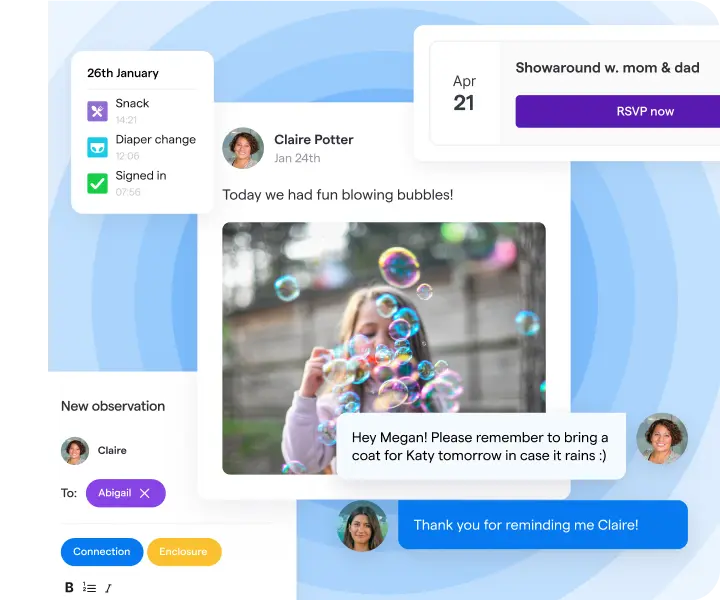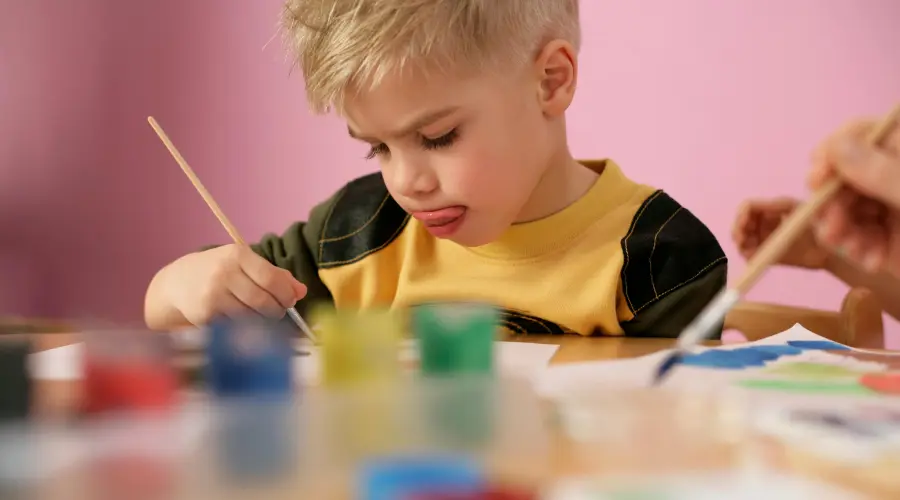settings
children
With Famly since

The observation and assessment process in early childhood education (ECE) can quickly get complex. Between the ages of birth and eight years old, their rates of physical, motor and linguistic development greatly outpace growth rates of later stages in life.
Child development is rapid, always ongoing, highly influenced by environmental factors, and is a uniquely individual process.
As an early years educator, you are witnesses to this growth every day. But how do you record all of it? And how do you know what to look for? That’s what makes preschool observations challenging.
In this article, we’ll look at what makes for meaningful observations and assessments in early childhood education , and how you can incorporate it into your day-to-day.

What is an observation?
Observations are a large part of an early childhood educator's job. But, it is not as easy as simply watching a child. A preschool observation requires knowledge and understanding of early development so that it can have purpose, direction and actionable insight.
"Education staff watch and listen to children and families to learn about each child's development and to figure out what and how each child is learning. Observation can also be described as paying close attention to a child's behaviors, interactions, activities, and interests, and noticing all aspects of the child's development.4 Both definitions stress the importance of observing with intention and observing to learn about a child."
What can you learn from observing children?
Just like each child has a unique personality, they also have their own unique path to growth. This path is something that the child determines, but as an educator, your observations can help guide and support that path.
Depending on the early childhood program, you may feel pressured to fit children's progress into some universal framework, as though every young children learns and grows at the same pace. But if we're assessing children with a standardized testing mindset, we're missing the big picture of growth and learning.
The big ideas

That's why observations are not - and should not be - about adhering to a standardized list of “normal” development points and checking off the boxes. Instead, they are about understanding each child's progress, but also understanding their personal interests, and getting to know them as social, emotional, and thinking individuals.
When observing with a more holistic approach, teachers can acknowledge their personal educational needs to help them develop successfully, and this will help influence learning activities and journeys for each child.

Assessing children's progress as individuals
Your assessments should be a balance of observing, reflecting and forward planning. And as we know, there is no one-size-fits-all in learning and development, so educator's observations and assessments should be personalized and unique to each child.
Teaching organizations and national and local education groups typically provide lists of general milestones and markers for various ages. Still, these should only be references because understanding child development on paper is way different than observing and assessing it in action.
There are so many factors at play that determine where early years children are on the developmental spectrum, that standardized observations and assessments relying on strict guidelines aren’t the best way to assist children on an individual level.
According to the National Association for the Education of Young Children (NAEYC) appropriate early years child assessment should consist of observing, documenting and assessing each child’s development and learning. In early childhood programs, you can do this through organized programs and activities, and also through observation of children engaging in unplanned play and spontaneous conversation and interaction during group and individual activity.
This all sounds great on paper, but what does that literally look like in your childcare center?
Tips to write meaningful observations in early childhood education
To help you write the best individualized and insightful observations, we'll look at five general categories of early learning and development, as laid out in the Principles And Recommendations For Early Childhood Assessments published by the National Education Goals Panel.
As you record child development in your early childhood setting, it's worth looking for moments in children's day when you see them express growth in these five areas.
1. Physical wellbeing and motor development
As an infant, there are a slew of physical milestones we all look for such as grabbing, sitting up and crawling. This development can be fairly obvious in the classroom as you're just watching for what the children physically do.
Still, to help with more detailed observations and assessments, it can be helpful to provide a variety of materials and toys that emphasize gross motor development, such as soft materials to throw and catch, and objects of different shapes, sizes, weights and colors. If a child isn’t physically engaging in an activity you can make note and follow up to see what they might be having trouble with, and see if it is a pattern.
2. Social and emotional development
In their first few years of life, children gain social and emotional skills, like regulating emotions, sharing, and following instructions.
In your center, you can see how the children express themselves, develop relationships with other children and learn through exploration of their environment. From there you can gauge the social and emotional development of the class. Maybe one child isn’t able to work with another or is displaying a different emotion than others in response to a lesson.

3. Children's approaches towards learning
Something many people likely don’t think about is the fact that we all had to learn how to learn, and the way we first teach children how to learn is through play.
Engaging children in games and activities helps establish curiosity about the world, initiative and problem solving, and focused attention and persistence. In the classroom you can observe who isn’t picking up on the activities as quickly or learning a new skill in the same way as others. Perhaps they need a little extra time or it explained in a different way. Remember just because a child isn’t learning something in the same way, it doesn’t mean they don’t have the capacity to learn it.
4. Language development
If a child doesn’t have appropriate language and communication skills for their age, it’s going to be that much more difficult to make a reliable assessment of their other abilities.
Engaging children in conversation, story time, listening to music, singing nursery rhymes, and other verbal activities promotes language development, and especially with group activities, makes it more apparent who isn’t communicating in the same way or on the same level.
5. Cognition and general knowledge
Cognition and general knowledge is about children learning to understand the world and focus on intellectual development through discovery and problem solving. This is where mathematical thinking, scientific thinking, and rationale come into play.
Children learn by making connections between new information presented to them and what they already know. In the classroom, if a child doesn’t understand a reaction to a certain action or activity try circling back around and explaining it again, or ask them more questions about it. See if they can come to the conclusion on their own with a little time and a push in the right direction (exactly why we love open-ended questions).
Using assessments to reflect and forward plan
If all this sounds like a lot of work, it certainly is, but it’s nothing to stress out about and should be approached as a long-term game.
As an educator in ECE, you aren’t expected to have all the answers from the get go. The act of observing, documenting and assessing children's development should be a continuous practice. It should be ongoing, strategic, reflective and purposeful.
A child’s learning process is always developing, so your assessments should be too. And the beauty of small, recurring assessments is that mistakes are very low-stakes. For example, if you assess that a child should be reading at a certain level and assign them a book that is too easy, you can simply give them something more advanced. It's okay to adjust your assessment methods over time, as you build your own skills and get to understand each particular child.
Your personal writing assistant
Fix spelling, grammar, and improve the tone of every message and newsfeed post. All with Sidekick.
Learn how Sidekick works










